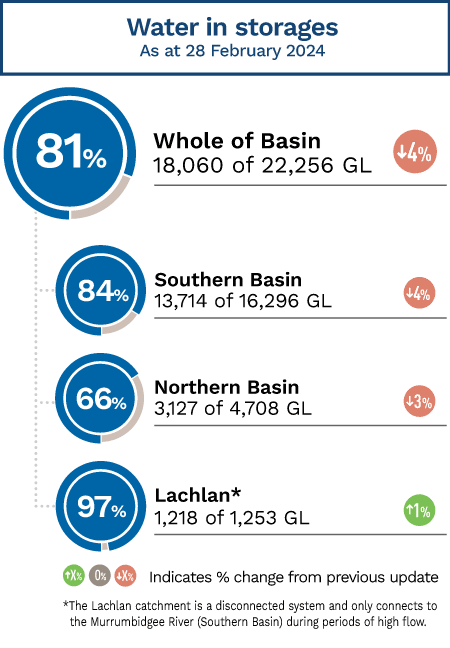- Mixed rainfall across the southern and northern Basin
- Long-range forecast for autumn predicts below average rainfall is likely
- The likelihood of water quality issues is typically higher over the warmer months
- Conditions across the Basin’s rivers and storages remain favourable for blue green algae outbreaks.

Drought
Following January’s above average rainfall across most of the Basin, February presented quite a different picture. Below average to very much below average rainfall was recorded in the most southern and northern parts of the Basin.
Despite this drier picture of the outskirts of the Basin, above average to very much above average rainfall was recorded across the mainland in New South Wales and areas of the south-western Queensland.
Longer term rainfall deficiencies of 10 to 15 months continued across small areas of the Basin in north-eastern New South Wales and south-eastern Queensland.
High root zone soil moisture levels continued through February, with most areas of the Basin recording average to above average levels.

Rainfall
A number of weather events saw high rainfall continue across the northern Basin and upper parts of southern Basin. Highest rainfall for the southern Basin was recorded in the Lachlan catchment, with Tuena receiving more than 153mm.
The rest of the southern Basin was significantly drier, with some areas of the Lower Murray and Wimmera catchments recording no rainfall for the month of February.
The highest rainfall for the northern Basin was recorded in the upper Warrego catchment, with areas of the Carnarvon Range receiving more than 189mm.

Water storages and streamflow
As of 28 February 2024, total storage in the Basin was 18,060 GL (81%), which is a 4% decrease from January. Northern Basin storages decreased by 19%, southern Basin storages by 4%, and the Lachlan catchment increased by 1%.
The Murray River is now regulated from Hume Dam to the South Australian Border. As we approach a suspected dry autumn, regulated conditions will see a return to lower flows across the River Murray system as water is conserved in Hume Dam to support future allocations.
Releases at Dartmouth Reservoir continue above the minimum to help balance the risk of spill between Dartmouth and Hume Dams while responding to demand downstream of Hume.
Regulator gates at the Kolety/Edward River offtake are clear of the water to maximise inflow, whilst flow in the Murray is relatively low.
Diversions to Colligen Creek are in place to help improve the condition of native fish populations by improving water quality and productivity.
On the Darling (Baaka), releases also continue from Weir 32 at Menindee Lakes to support water quality outcomes upstream.
February saw higher outflows at Lake Victoria (Tar-Ru) to meet entitlement requirements at the South Australian border and lake storage volume in accordance with the Lake Victoria Operating Strategy as specified in the Objectives and Outcomes for River Operations in the River Murray System.
Climate outlook
The Bureau’s long-range forecast for autumn predicts maximum and minimum temperatures are likely to very likely to be above median for most of Australia. March to May rainfall is likely (60% to 80% chance) to be below median for much of northern and eastern Australia.
There is a moderate flood warning for the Paroo River in Queensland.
The long-range forecast is influenced by several factors, including record-warm oceans globally and a weakening El Niño.

Water quality
The likelihood of water quality issues is typically higher over the warmer months. Conditions across the Basin’s rivers and storages remain favourable for blue-green algae outbreaks. In the lower Darling (Baaka) there is still a risk of low dissolved oxygen levels.
Summary of key water quality issues
- Low dissolved oxygen: The risk of low dissolved oxygen conditions will increase with prolonged hot and dry conditions. In the lower Darling (Baaka), dissolved oxygen levels generally remain near or above critical ecological thresholds, with adaptive management actions being undertaken to maintain or improve dissolved oxygen levels as required. Low dissolved oxygen levels are also being recorded immediately downstream of Hume Dam. This can occur when Lake Hume becomes seasonally stratified (layered) with poorer quality water released from the deeper levels of the lake. Adaptive operational responses are being utilised to mitigate this risk when it occurs.
- Blue-green algae: There is currently a risk of blue-green algae across most parts of the Murray–Darling Basin, particularly in New South Wales and Victoria. For the latest information on blue-green algae alerts, contact the relevant state government contacts via the Getting information about current algal blooms page of our website.
- Elevated Salinity: Some areas are seeing elevated salinity levels.
Water quality in the Murray–Darling Basin is monitored by individual Basin state governments. Specific water quality alerts are issued by respective states.
You can find all the latest news in our Newsroom or by following our socials: Facebook, X (Twitter), LinkedIn.